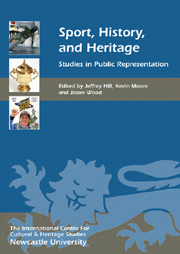Book contents
- Frontmatter
- Contents
- List of Illustrations
- Acknowledgments
- Sport, History and Heritage: An Investigation into the Public Representation of Sport – Editors' General Introduction
- HISTORY, HERITAGE AND SPORT
- 1 Sport, History and Imagined Pasts
- 2 Discredited Class-war Fable or Priceless Promotional Asset? The Duality of Rugby Union's William Webb Ellis Foundation Myth
- 3 Cricket Writing, Heritage and Ideology
- 4 Football and the Fine Arts: The Football Association Art Competition and Exhibition, 1953
- 5 ‘It's Nice to Belong’: Boxing, Heritage and Community in London
- 6 Television and the ‘Austerity Games’: London 1948
- MUSEUMS AND THE REPRESENTATION OF SPORT
- SURVIVALS AND LEGACIES: SPORT, HERITAGE AND IDENTITY
- Afterword: History and Heritage in Sport
- List of Contributors
- Index
- HERITAGE MATTERS
3 - Cricket Writing, Heritage and Ideology
from HISTORY, HERITAGE AND SPORT
Published online by Cambridge University Press: 05 April 2013
- Frontmatter
- Contents
- List of Illustrations
- Acknowledgments
- Sport, History and Heritage: An Investigation into the Public Representation of Sport – Editors' General Introduction
- HISTORY, HERITAGE AND SPORT
- 1 Sport, History and Imagined Pasts
- 2 Discredited Class-war Fable or Priceless Promotional Asset? The Duality of Rugby Union's William Webb Ellis Foundation Myth
- 3 Cricket Writing, Heritage and Ideology
- 4 Football and the Fine Arts: The Football Association Art Competition and Exhibition, 1953
- 5 ‘It's Nice to Belong’: Boxing, Heritage and Community in London
- 6 Television and the ‘Austerity Games’: London 1948
- MUSEUMS AND THE REPRESENTATION OF SPORT
- SURVIVALS AND LEGACIES: SPORT, HERITAGE AND IDENTITY
- Afterword: History and Heritage in Sport
- List of Contributors
- Index
- HERITAGE MATTERS
Summary
Have you not ever felt the urge to write
Of all the cricket that has blessed your sight?
(Blunden 1945, 5)There is little doubt that of all sports to have originated in the British Isles, cricket is the most literary. In 1991 the updated edition of Padwick's Bibliography of Cricket listed over 10,000 items, a figure that is now likely to have increased exponentially given the global growth in cricket's popularity, particularly in South Asia (Eley and Griffiths 1991). As well as the sheer quantity of cricket books, the sport has attracted the attention of a great many literary figures and this has lent the game a distinctly bookish aura, something that has tended to privilege it socially and culturally over other sports. In addition to portrayals of cricket by such resoundingly canonical literary figures as Charles Dickens and E M Forster, cricket developed a tradition of cultured belletrism, a body of reflexive prose and poetry that to a great extent defined cricket's meaning and set out the parameters of how the sport could be commemorated and remembered. Ever since Mary Russell Mitford included a description of a country cricket match in Our Village (1824–32), a heritage of literary representations of cricket tended to privilege the past over the present, the rural over the urban and the amateur over the professional while, at the same time, setting out conservative ideals of social and gender relations.
- Type
- Chapter
- Information
- Sport, History, and HeritageStudies in Public Representation, pp. 33 - 44Publisher: Boydell & BrewerPrint publication year: 2012



